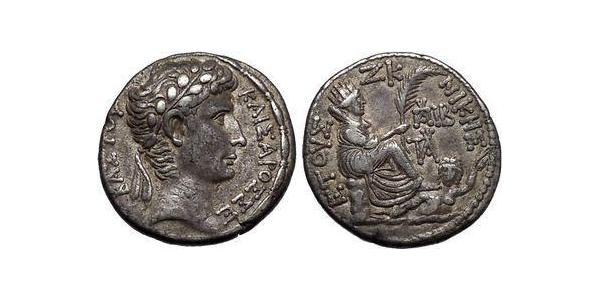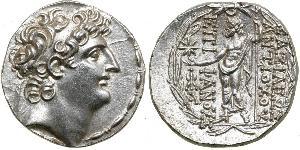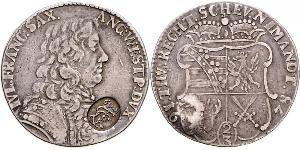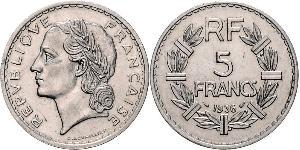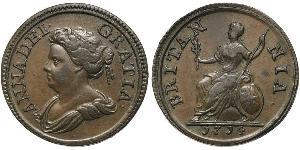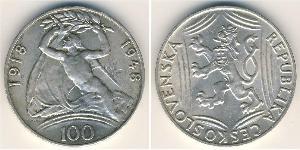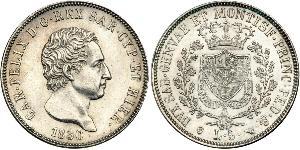[ 5301] AUGUSTUS Silver Tetradrachm (26.5 mm, 15.07 gm.) Seleucis and Pieria, Antioch - 27 B.C. -14A.D. Dated year 26 of the Actian Era and Cos. XII (5 BC). Reference: McAlee 180; Prieur 50; RPC I 4151; DCA 400. Laureate head right. ETOVΣ ςΚ (Actian era date) NIKHΣ, Tyche seated right on rocky outcropping, holding palm frond; below, river-god Orontes swimming right; to right, monogram (=ΥΠΑTOY) and IB (consular date) above monogram (=ANTIOXIEΩN?) Provided with certificate of authenticity. CERTIFIED AUTHENTIC by Sergey Nechayev, PhD - Numismatic Expert Augustus (Latin: IMPERATOR·CAESAR·DIVI·FILIVS·AVGVSTVS; 23 September 63 BC – 19 August AD 14), born Gaius Octavius Thurinus, was adopted by his great-uncle Julius Caesar in 44 BC, and between then and 27 BC was officially named Gaius Julius Caesar Octavianus. After 27 BC, he was named Gaius Julius Caesar Augustus. Because of the various names he bore, it is common to call him Octavius when referring to events between 63 and 44 BC, Octavian (or Octavianus) when referring to events between 44 and 27 BC, and Augustus when referring to events after 27 BC. He became the first emperor of the Roman Empire, which he ruled alone from 27 BC until his death in AD 14. The young Octavius came into his inheritance after Caesar's assassination in 44 BC. In 43 BC, Octavian joined forces with Mark Antony and Marcus Aemilius Lepidus in a military dictatorship known as the Second Triumvirate. As a triumvir, Octavian ruled Rome and many of its provinces as an autocrat, seizing consular power after the deaths of the consuls Hirtius and Pansa and having himself perpetually re-elected. The triumvirate was eventually torn apart under the competing ambitions of its rulers: Lepidus was driven into exile, and Antony committed suicide following his defeat at the Battle of Actium by the fleet of Octavian commanded by Agrippa in 31 BC. After the demise of the Second Triumvirate, Octavian restored the outward facade of the Roman Republic, with governmental power vested in the Roman Senate, but in practice retained his autocratic power. It took several years to work out the exact framework by which a formally republican state could be led by a sole ruler; the result became known as the Roman Empire. The emperorship was never an office like the Roman dictatorship which Caesar and Sulla had held before him; indeed, he declined it when the Roman populace "entreated him to take on the dictatorship". By law, Augustus held a collection of powers granted to him for life by the Senate, including those of tribune of the plebs and censor. He was consul until 23 BC. His substantive power stemmed from financial success and resources gained in conquest, the building of patronage relationships throughout the Empire, the loyalty of many military soldiers and veterans, the authority of the many honors granted by the Senate, and the respect of the people. Augustus' control over the majority of Rome's legions established an armed threat that could be used against the Senate, allowing him to coerce the Senate's decisions. With his ability to eliminate senatorial opposition by means of arms, the Senate became docile towards his paramount position. His rule through patronage, military power, and accumulation of the offices of the defunct Republic became the model for all later imperial government. The rule of Augustus initiated an era of relative peace known as the Pax Romana, or Roman peace. Despite continuous frontier wars, and one year-long civil war over the imperial succession, the Mediterranean world remained at peace for more than two centuries. Augustus expanded the Roman Empire, secured its boundaries with client states, and made peace with Parthia through diplomacy. He reformed the Roman system of taxation, developed networks of roads with an official courier system, established a standing army (and a small navy), established the Praetorian Guard, and created offi ...
type to read more

|
Posted by:
anonymous 2015-08-18 |
Similar Coin Groups
2025-05-23
- New coin is added to 5 Lira Italian city-states Silver Charles Felix of Sardinia
5 Lira Italian city-states Silver Charles Felix of Sardinia
group has 18 coins / 16 prices
⇑
Italian States - Sardinia. 5 Lire, 1830-P. Dav-135; KM-C105.1; Pagani-79a (R2). Mint mark, Eagle head. Carlo Felice. NGC graded Uncirculated, Details (Surface Hairlines). Estimated Value $300 - ...
2025-06-14
- Historical Coin Prices
You may be interested in ...

